rln Dienstglas 6x30 (Carl Zeiss Jena Monokular)
| Hier sind 6x30 Monokulare aus dem 2. Weltkrieg abgebildet, welche die Stempelung "Dienstglas 6x30 rln" sowie die Seriennummern 2264874 bzw. 151495 tragen - ein weiteres mit Nr. 151974. Die Kennzeichnung mit dem Dreieck (links bzw. rechts von 'rln') weist auf eine Verarbeitung mit Schmierfett hin, welches bei tiefen und hohen Temperaturen einwandfrei funktioniert. "rln" ist die Militärkodierung für die Fa. Carl Zeiss am Ende des 2. WKs (1944). Die blaue Färbung des Dreiecks ist beim 2. Exemplar erhalten. Die meisten der rln 6x30 Modelle wurden mit einem grauen oder grau-grünlichem Glattlack lackiert, seltener gibt es einige Exemplare in der sandfarbenen Europa-Einheitsfarbe. | Here you can see two 6x30 monoculars of WWII. They are marked "Dienstglas 6x30 rln" and "2264874" and "151495" – another one 151974 – as serial numbers. The triangle logo (left or right of 'rln') stands for the use of grease that withstands low and high temperatures. "rln" is the military production code for the Carl Zeiss company at the end of WWII (1944). The blue paint of the triangle is still there at the 2nd monocular. Most of the rln 6x30s were paitned with a grey or greenish-grey lacquer, some may have the sand-coloured "Europa Einheitsfarbe" (Europe unified colour). |
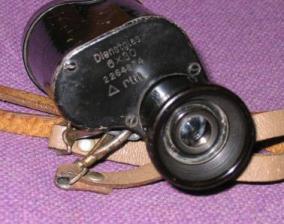
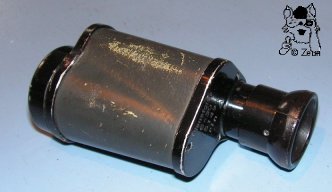
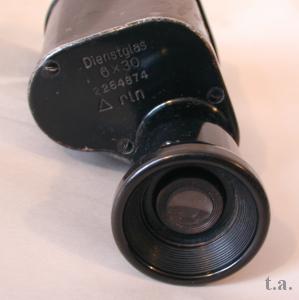
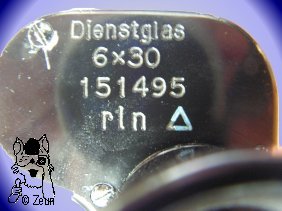
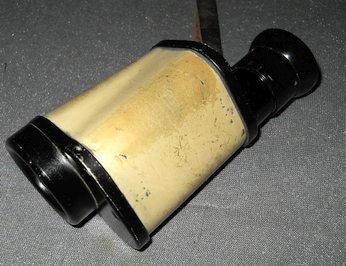
Das Gewicht des rln ist ca. 192g und seine Höhe 10,5cm bis 11,5 cm je nach Okularfokussierung. Das Gehäuse ist 5x5cm breit. Das Objektiv hat einen Durchmesser von 37mm (41mm beim 2. Exemplar). Das Okular besteht aus nur 2 Teilen: dem drehbaren Fokussierungsteil mit einfacher Skala, welche nur mit "+ | -" gekennzeichnet ist, und einer Kunststoffaugenmuschel. Das Gehäuse ist lediglich grau-schwarz lackiert ohne Ummantelung. |
The weight of the rln is ca. 192g and the height is 10.5cm to 11.5cm depending on the focusing of the ocular. The housing measures 5x5cm. The objective tube diameter is 37mm (2nd specimen: 41mm). The eyepiece has only two parts, first of which is the turnable focusing part with a simple dioptre scale marked "+ | -", and second a plastic eye-cup. The body is painted grey-black without any covering material. |
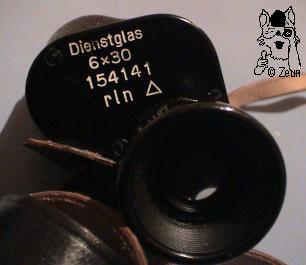
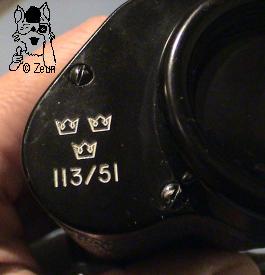
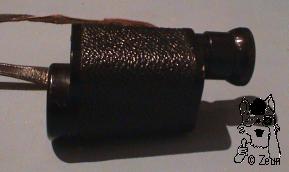
Ein weiteres Exemplar mit der Seriennummer 154141 ist für die schwedische Armee hergestellt und hat eine blau vergütete Optik. Am unteren Deckel trägt es das schwedische Kronensymbol aus 3 Kronen sowie die Nummer 113/51. Die Beschriftungen sind weiß gefärbt. Am Trageriemen befindet sich eine lederne Okularschutzkappe. Das Gehäuse ist mit strukturiertem Kunststoff (Vulkanit?) ummantelt. Der Lederköcher hat im inneren Deckel eine Halterung für einen Gelbfilter und ist außen mit dem Kronensymbol und der (schwer lesbaren) Zahl 563 und 1942 geprägt |
Another specimen with S/N 154141 was made for the Swedish Army. At the bottom prism cover it is marked with the Swedish crown symbol (3 crowns) and the number 113/51. The inscriptions are painted white. Fixed to the carrying strap is a leather cap for the ocular. The housing is covered with textured plastic (Ebonite?). The leather case lid has a pocket for the yellow filter inside, and stamped with the crown as well as the hardly readable numbers 563 and 1942. |

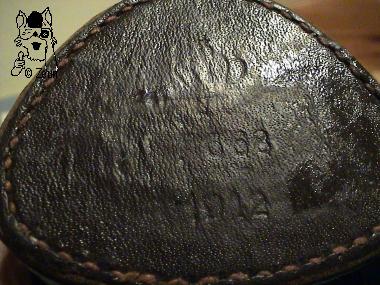
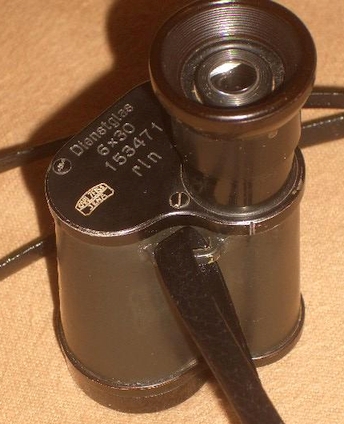
| Ein anderes Exemplar ist zusätzlich mit dem Carl Zeiss Linsenlogo auf dem Deckel versehen. Diese Nachgravur wird wahrscheinlich nach Ende des 2. Weltkrieges um 1945-1946 als noch vorrätige Teile weiter zu 6x30 Monokularen gefertigt wurden und als Reparationsleistungen oder, um offene Serien fertig zu stellen, geschehen sein. | Another specimen is also marked with the Zeiss lens logo on the cover plate. This engraving was most likely done afte WWII. about 1945-1946 when stored parts were used for further 6x30 monoculars which were built as reperations to the winning Allies or to finish planned series. |
Foto: Ebay-Auktion; 3 T.Antoniades; 2, 4-8 Zeun

